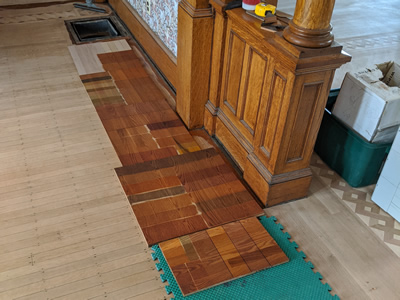
by Everett 5/19/2020
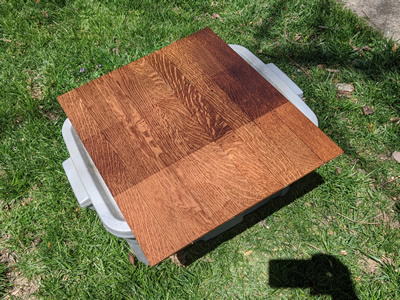
Now for one of the more unpredictable processes we encounter on any given job- coming up with a color. We only get one shot at this, so it has to be perfect. The client wanted something similar to what they had, but we always do samples to make absolutely sure. Rather than do the samples on their actual floor, which would require additional sanding to remove the samples once the decision is made, we built a panel with half old wood and half new wood to make sure there wouldn’t be a color difference. The existing color was sort of a reddish brownish orangish color, so we just chose 3 colors in those tones and coated it twice with Glitsa’s new Platinum formaldehyde free conversion varnish. We want the client to see exactly what they’re getting. Long ago we learned that if you just put down a stain color, once it dries the color seems to wash out a little bit. It really needs to have at least a sealer coat on it to see the true color.
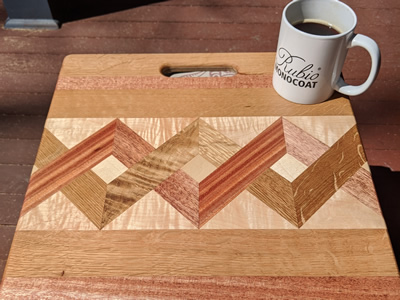
The problem with this is that even though it has no formaldehyde, that particular conversion varnish still has a very harsh odor, comparable to lacquer. Because of all this stay at home craziness, a finish like that simply isn’t going to work. Enter Rubio Monocoat penetrating finish. RMC oil actually smells pretty good, so that’s certainly a plus for this situation, but we’re still sort of apprehensive about products like this. It’s not a thing where there’s a legitimate concern about its durability, there are loads of flooring contractors out there who swear by it. It’s just a matter of having relatively little experience with it generally, and not having seen jobs that were done years ago that we could use to judge the durability of it specifically. Again this is one of those things where, for now at least, we just make the client aware of it, have them do their own research online and decide for themselves if they’d like to try it. In this case, the client did exactly that and was sold on it.
This makes coming up with a color even more challenging and unpredictable than it usually is because we don’t have years and years of experience with these colors- ie what each color looks like, which colors dominate others when blended, etc.. Not to mention, we don’t have every color on hand to try out like we do with the standard solvent based flooring stains. Rubio sells these tiny little bottles of their RMC oil for doing color samples, which is great but it’s still a whole new range of color options that we need to familiarize ourselves with- and fast. Another disadvantage is our lack of existing stain samples. Years ago I made small wood panels for every solvent based stain color, which is immensely helpful when trying to narrow down a color.
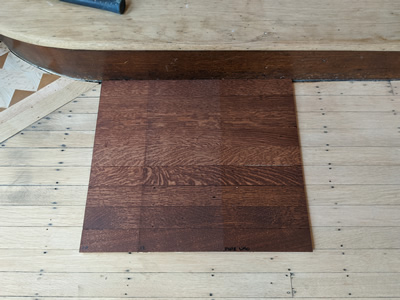
One thing we learned pretty much at the outset of our career in this field is that when doing stain samples, they need to be done on many boards rather than just one. When you look at a wood floor, each individual board has a slightly different shade. If we were to do one color on a dark board, then another color on a light board, and a decision were to be made based off of those- when done over the entire floor the color wouldn’t look like the single board sample. The sample panel or area on the floor that the color is applied to needs to be representative of the entire floor to accurately show what that color will look like when the whole floor is done in that color. I’m sure some have had the experience when painting walls where you go to the big box store, see millions of tiny paint swatches, choose one and have the guy behind the counter mix it up, only to start painting the walls with it and realize it’s not the color you had envisioned when you see it on your walls next to your trim.
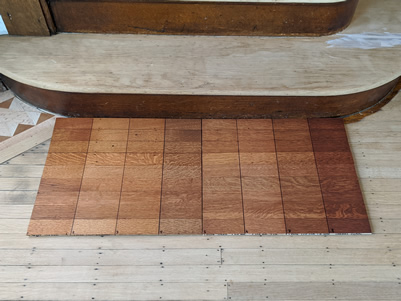
The reason I bring all that up is that because we don’t have multi-board panels with all the RMC colors on them, we have no choice but to rely on their little fan decks they hand out at demonstration days. These are just tiny little samples with printouts on paper of their colors, and like all fan decks they’re not really accurate at all. The only real purpose they served for us in this case is that the client could use them to give us some idea of the direction they wanted to go. The floor was to be a light orange to go with the trim, and they wanted the stairs to match the risers, which was a brownish red. After doing 49 colors on 3 or 4 panels, it was narrowed down to 8 colors. 49 colors sounds bad, but again this was mostly experimentation to see what these colors actually looked like on our panels. So I did those 8 colors on the half old half new panels I had made for this job. From there the client chose a floor color, and just wanted a small amount of brown added to the stair color.
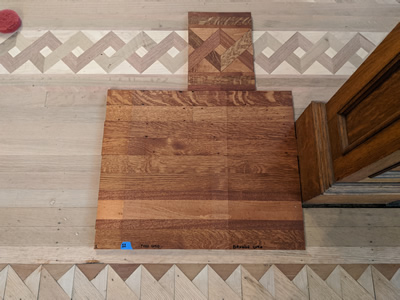
The only issue was that the floor color also had to look good on the border, I had of course made a small panel of the leftover border pieces for this exact reason. I did the color they chose for the floor on one whole panel and on the small border panel as a final sample just to make sure, and added some brown on the color we were close to on the stairs as well. Unfortunately the floor color made the maple in the border jump out at you with this garish, in your face bright orange color, so it was back to the drawing board for that one. The stair color was getting closer, it just needed a little more brown. On the next round I decided to build yet another panel that had maple and mahogany strips so that I could see what these colors did to the maple. Adding more brown to both colors got us even closer- we had a final decision on the stair color (yay!), but still needed a little more brown on that maple. At this point I remembered something I learned at the last Rubio demonstration day we attended. There’s this trend that some guys are doing lately called cerusing, or 2 tone. As an example, this could be an oak floor with a dark background, but with white down in the grain. When talking to the Rubio sales rep, it came out that you can also achieve this look by doing a dark color with RMC, then applying a product they offer called Universal Maintenance Oil in white over it. The reason that this occurred to me is that they also offer UMO in brown, which might just be the slight tinge of brown we need to calm this maple down.
So after one final round with the brown Universal Maintenance Oil over the floor sample panel (far right in the final pic), the client loved it and we had a final decision on the floor and stair colors. What a relief!


